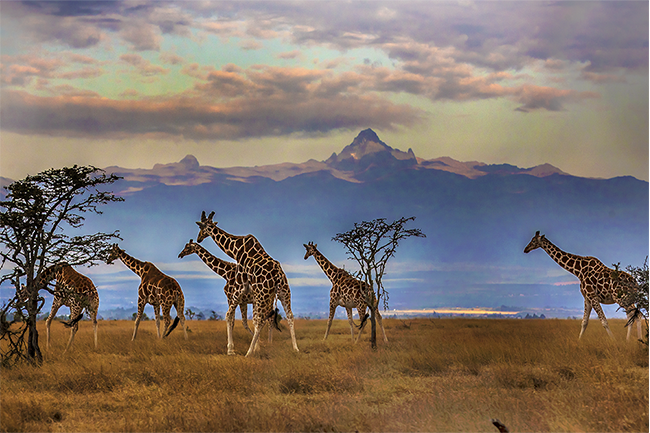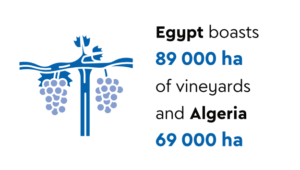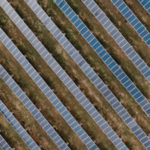Around 1.3 million wildebeest, 400 000 zebra and about 300 000 other antelope on the hoof for 800 km is an impressive sight, to say the least. Throw in 3 000 crocodiles waiting for them in the major rivers and hundreds of big cats flanking the proceedings and you have the makings of a spectacular wildlife ‘show’. The Great Migration, as it is known, is one of the seven natural wonders of the world and occurs annually as the herds trek clockwise from the Serengeti in Tanzania to the Masai Mara in Kenya in search of, literally, greener pastures.
The best time to view the Great Migration as a tourist is between July (as they leave the Serengeti) and October (when they depart the Masai Mara) on their return journey.
Although it is around one-tenth the size of the Serengeti, the Masai Mara’s 1 510 km2, part of which is owned by local Maasai communities, is renowned for having one of the highest concentration of wild animals in the world and is Kenya’s most recognised game park globally.
Tourism is Kenya’s second-highest foreign earner after agriculture and the COVID-19 pandemic had a devastating effect on the local economy. The gradual opening of air routes and vaccination campaigns in the past year has, however, seen a dramatic recovery. In September, outgoing Tourism and Wildlife Minister Najib Balala told Reuters that the country’s inbound tourism earnings more than doubled to KES167.1 billion in January to August, from KES83 billion in the same period a year ago.
He said Kenya expected to receive 1.46 million tourists by the end of the year. He was reported saying that the country was on its way to ‘full recovery attributed to resilience, growth of the domestic market and value addition to the tourism experience’.
Balala said the estimated arrivals were valued at KES265 billion. In 2019, just before the pandemic, the country received 2 million inbound visitors.
It is agriculture, however, that supports most of the population. According to the FAO, the sector contributes 33% of GDP and another 27% indirectly through its influence on other industries. About 40% of Kenyans work in agriculture – that figure is 70% in rural areas.
‘Periods of high economic growth rates have been synonymous with increased agricultural growth,’ a study by PwC says.
‘The tea sector is a dominant sector and the coffee sector has started to pick up following a decline in the recent past. The horticultural and flora sectors have seen unprecedented growth over the past years as more companies venture into production and export of flowers and fresh produce.’
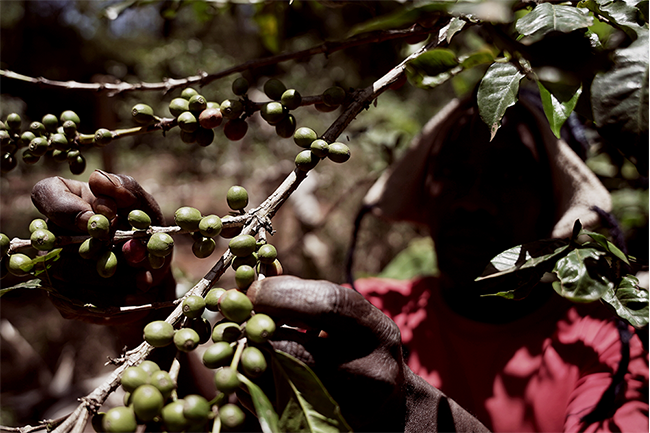
Yet much of the country (around 80% according to the AfDB) is classified as arid or semi-arid and remains susceptible to natural events, especially drought. ‘An average drought results in a food deficit of 20% to 30%, slashes GDP growth by 3% to 5%, and affects the livelihoods of over 80% of the population,’ says the bank.
Climate change, in particular, has an urgent focus for the authorities.
‘In line with its Vision 2030, Kenya has introduced policies and frameworks to tackle climate change,’ says the AfDB, adding that the government has ‘put in place mitigation and adaptation measures to achieve the COP26 emission reduction targets, which are forecast to cost US$64.9 billion between 2021 and 2030. They include increasing the share of renewables in the electricity generation mix, increasing tree cover to at least 10% of land area, building a low-carbon and efficient transportation system, and increasing the uptake of adaptation technology across all sectors. Kenya is exploring sources of climate finance such as carbon markets, the Green Climate Fund and the Africa Climate Change Fund. It is on track to meeting the five climate action targets of SDG 13 by 2030’.
The World Bank has recommended several policies that the country should address to strengthen and enhance the agri-economy. Among these are more access to agricultural financing (‘about 4% of commercial bank lending is for agribusiness’); the increased use of fertiliser (‘reforming fertiliser subsidies to ensure that they are efficient and transparent, and targeting smallholder farmers remains key in restoring productivity’); establishing structured commodities trading (‘the government still retains a big role in marketing agricultural outputs, especially maize, leaving little room for private-sector participation’); investing in irrigation (‘2% of arable land is under irrigation compared to an average of 6% in sub-Saharan Africa and 37% in Asia’); and supporting stronger farmer organisations (‘Kenya has many geographically dispersed smallholders that are not integrated into key agriculture value chains’).
Last year the World Bank approved a US$250 million International Development Association credit for a new ‘National Agricultural Value Chain Development Project’. This will target 500 000 small-scale farmers in 26 counties.
‘The project will unlock new opportunities for maximising finance and private-sector investments in the nine value chains through a range of value-chain investments and other enabling initiatives, such as improved subsidy targeting through e-vouchers and operationalising warehouse receipt financing,’ according to Keith Hansen, World Bank country director for Kenya. ‘It will engage intensively with private-sector value-chain actors to crowd in investments in agri-business opportunities such as input supply, access to finance for farmers and small and medium enterprises, digital extension services, farm-gate infrastructure development and maintenance, storage and cold chains, insurance schemes and consumer retail.’
However, it is Kenya’s ICT potential that perhaps holds the most attraction for investors. Known as the Silicon Savannah, the country was an innovator in mobile money services and its tech start-up scene is regarded as among the strongest on the continent.
Earlier this year, Disrupt Africa’s annual African Tech Start-ups Funding report stated that Kenya was the third-most successful country after Nigeria and Egypt in attracting financing. ‘US$447.4 million was raised by 45 start-ups, more than US$150 million more than the US$292 million the country raked in across 2021,’ it said. At the same time, Africa: the Big Deal, a database, stated that ‘Kenya is on an eight-month winning strike, with some incredible results – in April 2022, start-ups in Kenya raised 83 times the amount they had raised in April 2021’.
In an effort to attract more foreign investors, the International Financial Centre was launched in Nairobi in mid-year. Tailored to companies in the finance industry, it is also aimed at providing a space for local start-ups to acquire a more public profile and enter into seeding negotiations.
According to the Mail & Guardian, several of the world’s leading tech companies have ‘made concerted efforts to tap into Kenyan talents and business opportunities’.
It mentioned Microsoft (which launched one of two Africa development centre sites in Nairobi) and Google (which is hiring for its product development centre – the first one it will have on the continent). Visa has also chosen Nairobi for one of its global innovation hubs, and the newspaper said Amazon ‘expressed intent to launch an Amazon Web Services local zone’.
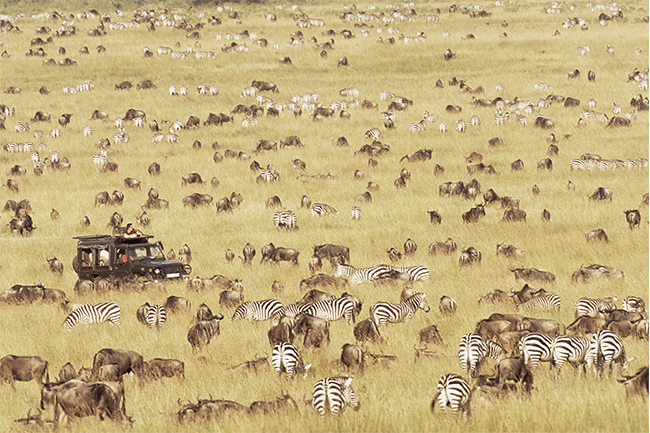
On the political front, the country has recently emerged from elections in August, which saw a tight victory for William Ruto, with runner-up Raila Odinga going to the courts to challenge it legally. The Supreme Court ruled the results were legitimate and Ruto was sworn in as president on 13 September.
The election was generally peaceful, as opposed to previous years, and observers regarded it as free and fair. As the Economist put it, ‘Kenya should still be able to burnish its claim to be one of Africa’s best-functioning democracies. Mr [Uhuru] Kenyatta is the third president in a row to respect constitutional term limits, making him a rarity on the continent. None of Kenya’s neighbours can match its history of holding competitive elections’.
There is much for Ruto to do. ‘Shoring up the economy is likely to be a key priority,’ according to a forecast by Allianz Trade. ‘The public debt burden stood at 67% of GDP as of June. And the external position is in a poor state too; in May, the trade deficit was the widest since at least 2000 as imports surged by more than exports grew. Activity probably deteriorated further since; the PMI dropped from 46.8 in June to 46.3 in July. Meanwhile, the currency has continued to weaken (-6% versus the US$ as of mid-September).’
The World Bank projects a 5% growth for this year, but points out that ‘although the economic outlook is broadly positive, [the country] is subject to elevated uncertainty, including through exposure (as a net fuel, wheat and fertiliser importer) to the global price impacts of the Russian invasion of Ukraine’. Of particular concern for the organisation is the state of education.
‘Kenya has huge regional inequalities in all education outcomes,’ it says.
‘Education outcomes are much lower in rural areas and for lower-income populations. Net enrolment rates are significantly higher in pre-primary, primary and secondary education for children from households in the top 20% of income distribution, compared to the bottom 20%.
‘Compounded by the pandemic, these challenges have led to learning losses and deepened inequalities in education. An estimated 17 million students and more than 320 000 teachers were affected by the closure of 30 000 primary and secondary schools in 2020.’
Despite the challenges, however, Kenya has much to commend itself for. It has resolutely stuck to a long-term development agenda, which can only build on what has already been achieved.

